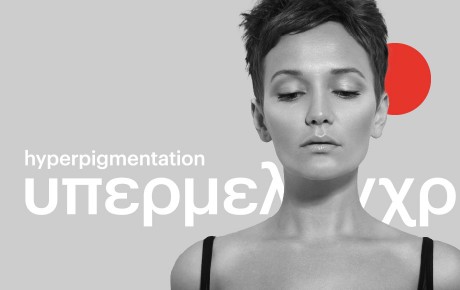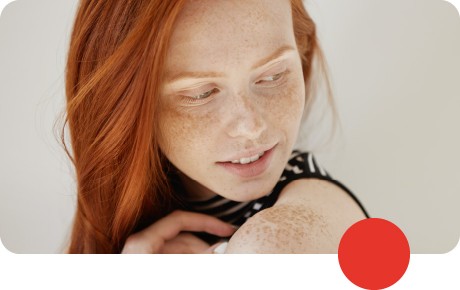Βιβίογραφικές αναφορές
1. Handel A, Miot L, Miot H. Melasma: a clinical and epidemiological review. An Bras Dermatol. 2014; 89(5): 771-782.
2. Ogbechie-Godec O, Elbuluk N. Melasma: an Up-to-Date Comprehensive Review. Dermatol Ther (Heidelb). 2017; 7(3): 305-318.
3. Addor F. Antioxidants in dermatology. An Bras Dermatol. 2017: 92(3): 356-362.
4. Monteiro R, Kishore B, Bhat R, Sukumar D, Maris J, Ganesh H. A comprehensive study of the efficacy of 4% hydroquinone vs 0.75% kojic acid cream in the treatment of facial melasma. Indian J Dermatol. 2013;58(2):157.
5. Jimbow K, Obata H, Pathak M, Fitzpatrick T. Mechanism of depigmentation by hydroquinone. Journal of Investigative Dermatology. 1972; 62(4): 436-449.
6. Bandyopadhyay D. Topical treatment of melasma. Indian J Dermatol. 2009; 54(4): 303-309.
7. Griffiths C, Finkel L, Ditre C, Hamilton T, Ellis C, Voorhees J. Topical tretinoin (retinoic acid) improves melasma. A vehicle-controlled, clinical trial. Br J Dermatol. 1993; 129(4):415-21.
8. Torok H. A comprehensive review of the long-term and short-term treatment of melasma with a triple combination cream. Am J Clin Dermatol. 2006; 7(4): 223-30.
9. Torok H, Taylor S, Baumann L. A large 12-month extension study of an 8-week trial to evaluate the safety and efficacy of triple combination (TC) cream in melasma patients previously treated with TC cream or one of its dyads. J Drugs Dermatol. 2005; 4(5): 592-7.
10. Gupta AK, Gover MD, Nouri K, Taylor S. The treatment of melasma: a review of clinical trials. J Am Acad Dermatol. 2006; 55(6): 1048-65.
11. Bala H, Lee S, Wong C, Pandya AG, Rodrigues M. Oral tranexamic acid for the treatment of melasma: a review. Dermatol Surg. 2018; 44(6):814-825.
12. Atefi N, Dalvand B, Ghassemi M, Mehran G, Heydarian A. Therapeutic effects of topical tranexamic acid in comparison with hydroquinone in treatment of women with melasma. Dermatol Ther. 2017; 7(3): 417-424.
13. Navarrete-Solis J, Castanedo-Cazares J, Torres-Alvarez B. A double-blind, randomized clinical trial of niacinamide 4% versus hydroquinone 4% in the treatment of melasma. Dermatol Res Pract. 2011. Doi 10.1155/2011/379173.
14. Sarkar R, Arora P, Garg K. Cosmeceuticals for hyperpigmentation: What is Available?. J Cutan Aesthet Surg. 2013; 6(1):4-11.
15. Espinal-Perez LE, Moncada B, Castanedo-Cazares JP. A double-blind randomized trial of 5% ascorbic acid vs. 4% hydroquinone in melasma. Int J Dermatol. 2004;43(8):604–607.
16. Al-Niaimi F, Chiang N. Topical vitamin C and the skin: Mechanisms of action and clinical applications. J Clin Aesthet Dermatol. 2017; 10(7): 14-17
17. Balina L, Graupe K. The treatment of melasma. 20% azelaic acid versus 4% hydroquinone cream. Int J Dermatol. 1991;30(12):893-5.
18. Verallo-Rowell V. Verallo V, Graupe K. Lopez-Villafuerte L, Garcia-Lopez M. Double-blind comparison of azelaic acid and hydroquinone in the treatment of melasma. Acta Derm Venereol Suppl. 1989; 143: 58-61.
19. Sarkar R, Bansal S, Garg V. Chemical peels for melasma in dark-skinned patients. J Cutan Aesthet Surg. 2012; 5(4): 247-253.
20. Lim J. Treatment of melasma using kojic acid ina gel containing hydroquinone and glycolic acid. Dermatol Surg. 1999; 25(4): 282-4
21. Bissett D, Robinson L, Raleigh P. Reduction in the appearance of facial hyperpigmentation by topical N-acetyl glucosamine. J Cosmet Dermatol. 2007; 6(1):20-6


